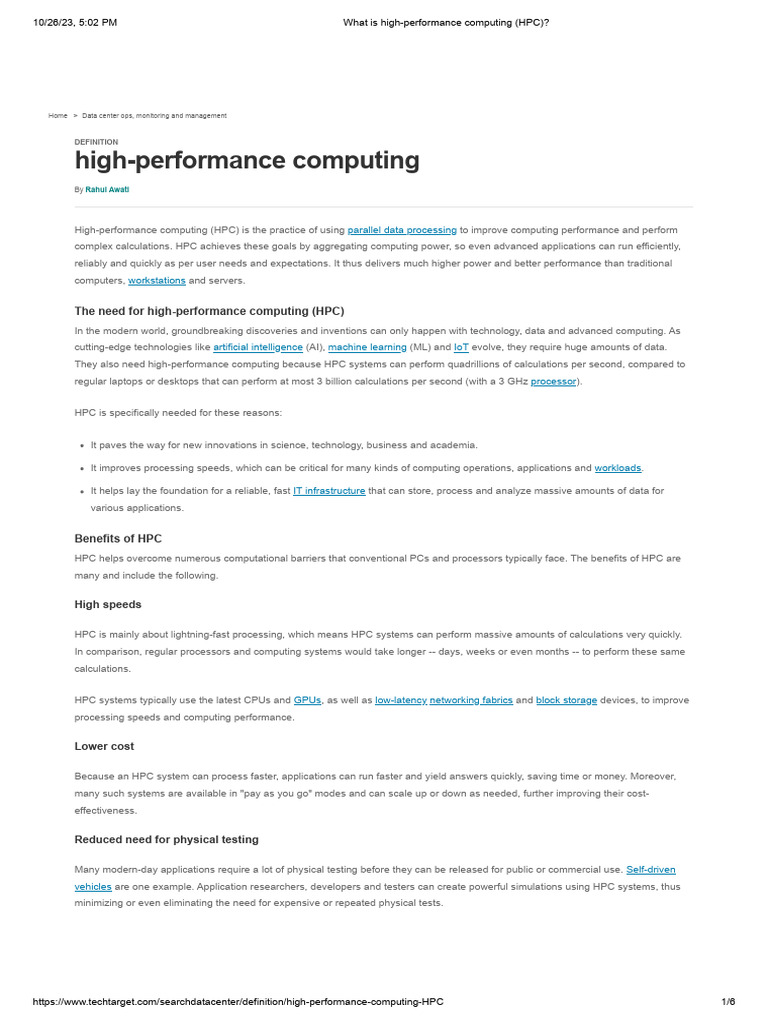The realms of High-Performance Computing (HPC) and cloud computing have emerged as two pivotal paradigms in the field of computing today. As technology progresses, it is natural to ponder the extent to which these two formidable forces intersect and diverge. Can we equate the sheer computational power of HPC to the pervasive flexibility of cloud computing? This inquiry requires a multifaceted examination of their characteristics, architectural frameworks, advantages, and limitations. While they share certain synergies, HPC and cloud computing are ultimately distinct in their core functionalities and intended applications.
To commence, it is essential to delineate the fundamental principles behind HPC. High-Performance Computing refers to computational systems that deliver exceedingly high performance, typically employed to solve complex computational problems that are beyond the reach of traditional computing systems. These problems span a spectrum, including climate modeling, molecular dynamics simulations, financial risk analysis, and artificial intelligence. HPC systems are characterized by their capacity to process an immense volume of data simultaneously, leveraging massively parallel processing to achieve accelerated results.
On the contrary, cloud computing encapsulates a different philosophy. It is fundamentally an on-demand service model that provides a myriad of computing resources—servers, storage, databases, networking, software, and more—over the internet. Cloud computing can be categorized into three primary service models: Infrastructure as a Service (IaaS), Platform as a Service (PaaS), and Software as a Service (SaaS). The appeal of cloud computing lies in its scalability, cost-effectiveness, and flexibility, enabling users to procure computing resources as needed without the overhead of managing physical infrastructure.
The architectural contours of HPC and cloud computing further delineate their differences. HPC systems are often tailored to optimize performance, utilizing specialized hardware such as multi-core processors and graphics processing units (GPUs). These systems are typically housed in data centers specifically designed for minimal latency and maximum throughput. They demand high levels of interconnectivity between nodes, thus allowing for efficient sharing of workloads across computational clusters.
Conversely, cloud infrastructures operate on a general-purpose model. They are built to accommodate variability in workloads and user demands, often relying on virtualization technologies to provision resources dynamically. This elasticity facilitates a more democratic computational environment where individual users can harness the power of cloud resources without necessarily requiring advanced technical prowess.
Despite their differences, it is crucial to recognize the converging trends influencing both HPC and cloud computing. Recent developments have witnessed the rise of HPC cloud. This hybrid approach offers the computational potency of HPC within a cloud architecture, enabling users to access high-performance resources without the necessity of investing in proprietary hardware. Such an approach furthers democratization, allowing smaller research institutions and businesses to tap into HPC capabilities that were previously the domain of the affluent and powerful.
Therein lies a promising shift in perspective. The democratization of HPC through cloud computing propels scientific discovery across disciplines, fostering collaboration and innovation unparalleled in history. With the help of cloud-based HPC resources, researchers can conduct large-scale simulations and analyses with unprecedented efficiency. This collaborative ethos is enhanced by the accessibility of vast data repositories and analytics tools residing in the cloud, vital for domains such as genomics and materials science.
Nonetheless, the integration of HPC into the cloud paradigm is not without its challenges. Bandwidth limitations, latency issues, and data security are pivotal considerations when transferring large datasets to and from cloud environments. Additionally, the computational intensity often associated with HPC workloads may become impeded by performance variability inherent in multi-tenant cloud infrastructures. Thus, achieving an equilibrium where the strengths of both environments can be harmonized requires ongoing innovation and engineering ingenuity.
Furthermore, the implications of this dichotomy extend beyond mere computational woes. The disparities in cost structures warrant thorough examination. While HPC tends to involve significant upfront capital investments—with expenses associated with hardware setup, maintenance, and energy consumption—the cloud computing model primarily operates on a pay-as-you-go basis. This operational expenditure model aligns better with the fiscal prudence demanded by many organizations, particularly small to medium enterprises and academic institutions.
Despite the allure of cloud computing, challenges such as vendor lock-in and concerns regarding data sovereignty remain noteworthy barriers limiting its adoption in specific sectors, notably finance and healthcare. The nuances of regulatory compliance further complicate matters, prompting stakeholders to tread cautiously when migrating sensitive data to cloud environments.
In conclusion, while High-Performance Computing and cloud computing each possess formidable capabilities and merits, equating them would be a categorical oversimplification. They serve different, albeit complementary, purposes, particularly in the contemporary landscape where computational needs continuously evolve. HPC provides unparalleled performance for intensive computational tasks, while cloud computing presents a flexible, scalable, and economically viable solution for diverse workloads. The future undoubtedly lies in their convergence, fostering an ecosystem where high-performance systems can operate seamlessly within cloud architectures, propelling academic discoveries, innovation, and technological advances to new heights.












